This fly is a bright and tasty looking bite of feathers and fur that can sometimes be the key to luring a big trout. It's a variation of a variation of the Bloody Butcher.
We recently covered a sea trout version of the classical Bloody Butcher. Here's a variation of the variation: the Bloody Butcher wet fly converted to sea trout fly converted to a zonker.
This variation of the variation was originally tied for sea run brown trout - sea trout - but will work equally well as a big trout streamer in running water and I would be surprised if salmon wouldn't like it, and I wouldn't mind casting it to large saltwater predators such as tarpon, tuna or trevally... but then I wouldn't mind casting any fly pattern to these quarries, but that's a whole other matter.
The flies you see have all been tied by our designated staff tyer Ken Bonde Larsen, and looking at the tying sequence you may want to take note of a few tying tips, which I will take this opportunity to point out.
|
|
|
|
|
|
|
|
|
|
Durable tinsel body
|
|
|
|
|
|
|
|
The body on this fly is tinsel, and tinsel is notoriously fragile if it's just wound on a hook shank. A rib will help, but once the tinsel breaks (can you say fish teeth?) it will magically unravel no matter how secure it seemed when the fly was done.
The cure is glue... or rather nail polish that not only glues the tinsel, but also seals it when it's been wrapped and tied down.
Spread a thin layer of clear nail polish on the foundation for the body, and wind the tinsel while the polish is still sticky. If you use two layers of tinsel, add nail polish in between. And when the body is done, coat it with a thin layer of nail polish and let it dry before continuing. The advantage of nail polish over fly varnish is that is dries quickly and dries up "thick" with a bit of volume, smoothing out any bumps on what it covers.
Securing a zonker wing with the rib
|
|
|
|
|
|
|
|
|
|
|
|
|
|
|
On many zonker patterns you only tie in the zonker strip in the front and in the rear. This can lead to a loose and soggy wing because the skin base of the wing sucks up water and becomes slightly larger and much softer compared to the dry strip.
Avoid this by tying down the strip in its full length with a rib. Tie the wing down in front with the tying thread, moist the hairs of the wing to be able to separate them, and wind the rib in fairly close turns without squashing down any hairs. Start with a full turn of the ribbing material to secure the rear end, and then move forward in 5-7 turns depending on the length of the hook.
Making a neat front on a zonker wing
|
|
|
|
|
|
|
|
|
|
When you tie down the zonker strip on the front of the fly, you often get a fairly large bump under the thread - and under the head or the front hackle. You can avoid this by leaving a little space in front of the wing, and finishing it with a small bunch of hair similar to that on the strip.
This will cover the ugly bump caused by the skin strip, and form a smooth foundation for a front hackle or make it much easier to form a small head.
Using a brush on a soft hackle
|
|
|
|
|
|
|
|
|
|
You know how some tyers are able to get the soft front hackles on their wet flies to sweep back over the body like they were glued in place? Well, there are techniques to make this happen by just tying the feather in in the right way. But not only can you do that, but when the hackle is done, and doesn't act exactly as you want, you can simply comb it in place!
Make yourself a hackle and fur comb by cutting down an old (or new) toothbrush, and stroke this firmly over the hackle from the flies' head and back, and you'll be surprised how even and nicely swept back it can become.
- Log in to post comments


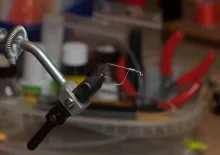



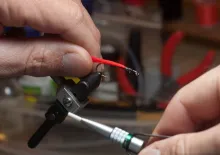

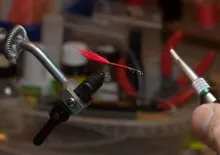







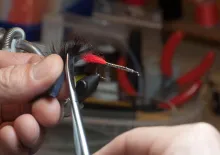



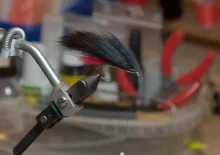


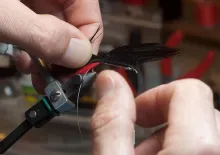


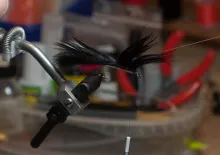















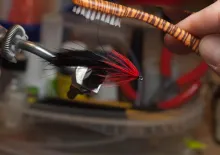










Jan,
The tier is
Jan,
The tier is Ken Bonde and not myself, but I think the scissors are from Dr. Slick and a model, which is curved and serrated. I always use straight scissors myself, but I'm sure the Dr. Slick will work fine for deer hair as it does for other types of tying.
Martin
Hi Martin,
your a
Hi Martin,
your are using a curved scissor. Would you tell what scissor it is and if you are using it also for deer-hair-flies. I am looking for a good curved scissor.
Thanks.
Jan
Dear anonymous,
C
Dear anonymous,
Click on the image to get a larger and better version, where the details are more visible. We have heard your comment before, and while I certainly respect the view I don't think the problem is that severe, and I honestly don't think that uniform, colored backgrounds are good for anything else than analytical images, documenting flies.
I have changed the backgrounds on the latest tying series (this one was shot in 2009), but don't expect us to turn to absolutely uniform backgrounds anythime soon. These flies are usually tied at a tying desk, and shot over the shoulder of the tyer, and although we will make the table and background tidier, it will probably never be 100% uniform.
Martin
It would be nicer to
It would be nicer to follow if some sort of light background was behind the fly tying rather than a clutter of gear, find it difficult to follow, sorrry.